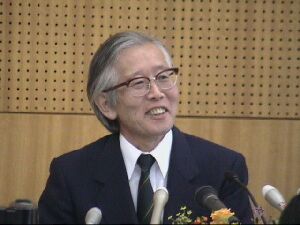
Prof. Shirakawa, at the Press Conference at the University Hall(Oct. 13, 2000)
 |
Prof. Shirakawa, at the Press Conference at the University Hall(Oct. 13, 2000) |
ü@
| The Royal
Swedish Academy of Science has announced that the Nobel Prize in chemistry, 2000, was
awarded to Professor (Emeritus) Hideki Shirakawa (Institute of Materials Science,
University of Tsukuba, Japan), who jointly shared with Professor Alan J. Heeger (University of
California at Santa Barbara, USA) and Professor
Alan G. MacDiarmid (University of Pennsylvania, USA) for the discovery and
development of conductive polymers on Oct.10, 2000. Professor Shirakawa has been a
faculty member of Institute of Materials Science, University of Tsukuba for more than 20
years and has dedicated his life to both his research and education. He explored a
unprecedented new area of polymer science by leading insulating polyacetylene to
electrically conducting one. This achievement was often said to be triggered by an
accidental mistake --a thousand fold too much catalyst was added during synthesis of
polymer-- resulting in a beautiful silvery film which possess many superior properties to
metals when he was a research associate of Chemical Resources Laboratory at Tokyo
Institute of Technology. When Professor Alan MacDiarmid heard about the film synthesized by Dr. Shirakawa, he invited him to the University of Pennsylvania in Philadelphia as a post-doctral fellow. They worked together with Dr. Alan Heeger in order to understand the mechanisms of the appearance of conductivity in insulating polymers and finally came to a conclusion that it is possible to introduce carriers in polymers by doping: modifying polyacetylene by oxidation with halogen vapor. In 1977, Shirakawa, Heeger, MacDiarmid, and others published their discoveries in "Synthesis of electrically conducting organic polymers: Halogen derivatives of polyacetilene (CH)n" in The Journal of Chemical Society, Chemical Communications. The discovery was considered a major breakthrough in the field of polymer science. Since then, the field has grown greatly and has also led to immerse new applications in the present days. For example, LEDs (light emitting diode), new color screens, batteries, and etc. We think that in the 21st century this development will proceed further from polymer based electronics to real molecular based nano-scale integrated circuits instead of presently used silicon based electronics. We also believe and hope that this kind of nano-scale materials science will bring us further property in our human society. Oct. 12, 2000 |
Press conference at University Tsukuba
(2000.10.13)
Celeblation at Institute of Materials Science
(2000.10.13)
University's official events for celebration (2000.12.19)
Prof. Akagi's
Laboratory (the closest collaborators)
The Nobel Foundation
Department of Physics, University of California at Santa Barbara
School of Arts and Science, University of Pennsylvania
Tokyo Insitute of Technology
The Society of Polymer Science,
Japan (in Japanese)
Cerebration from Prime Minister Mori at the Kantei